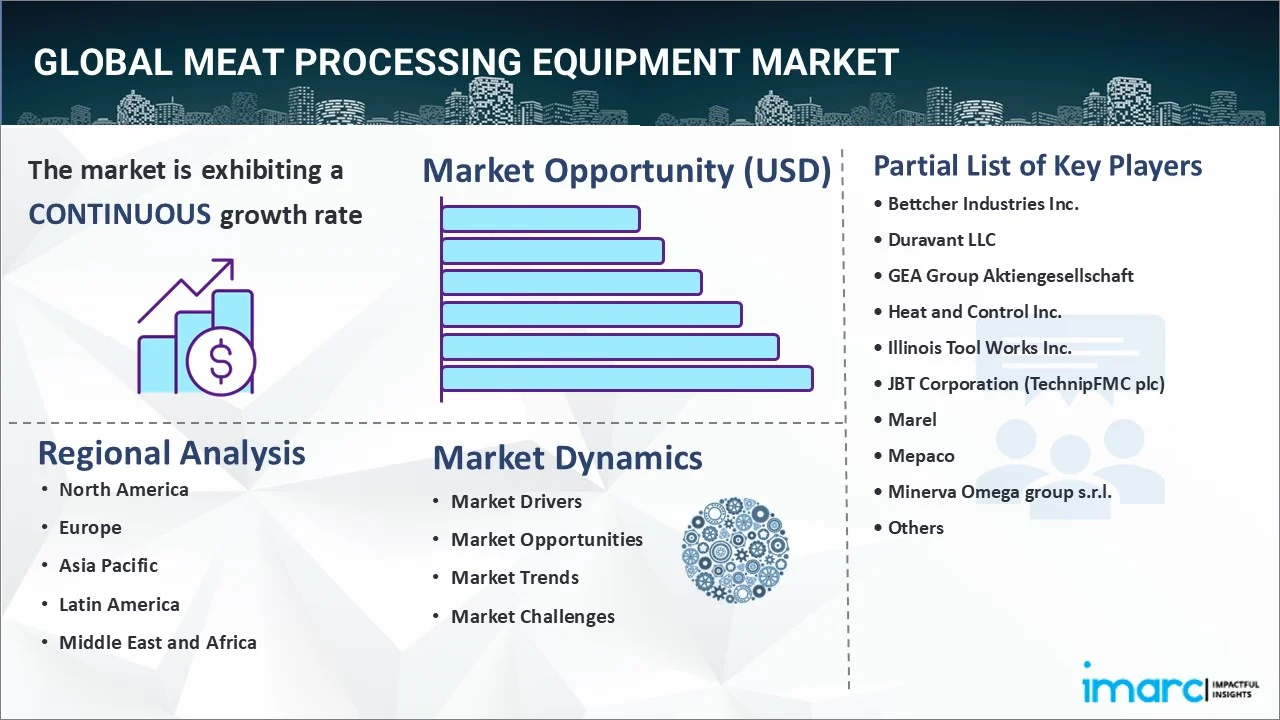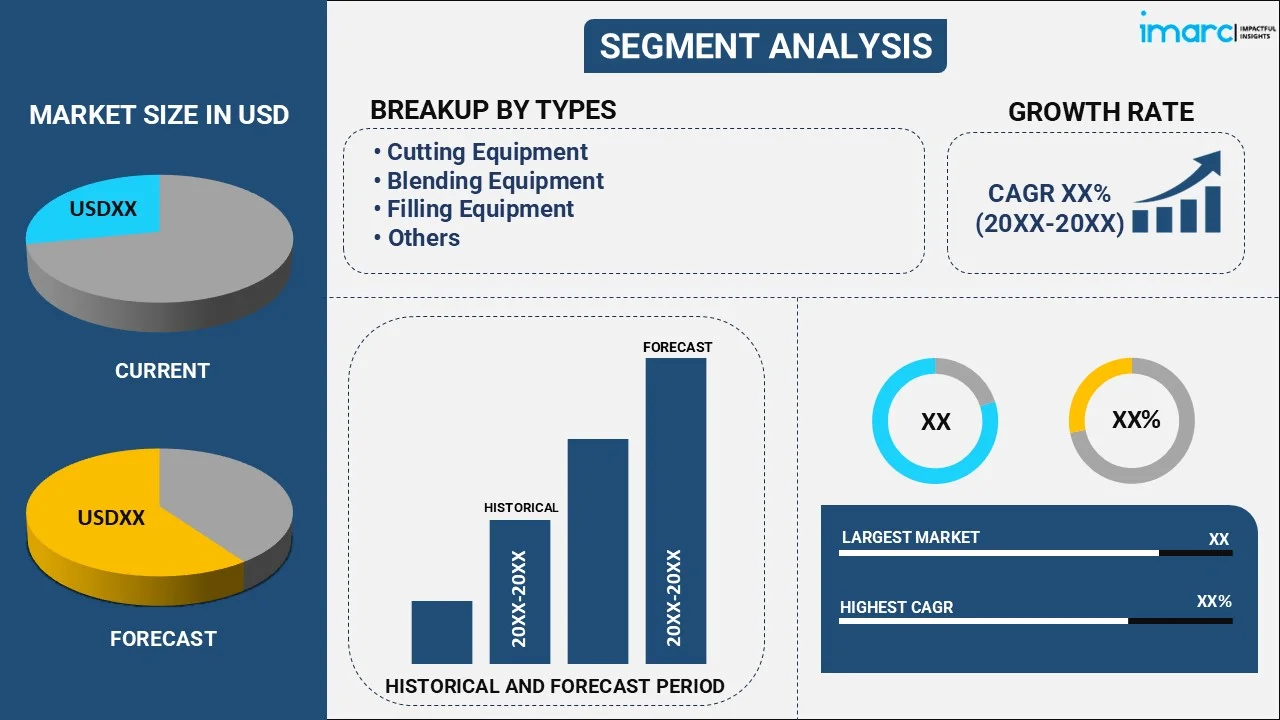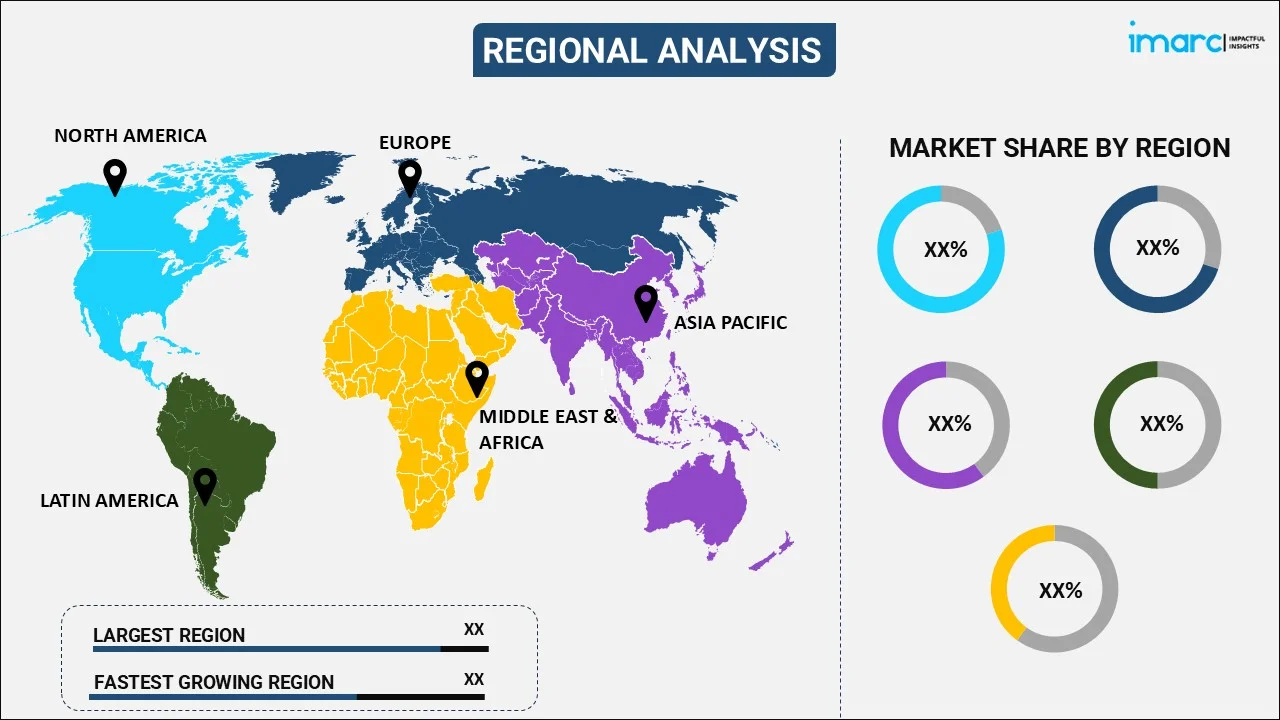
Meat Processing Equipment Market Report by Type (Cutting Equipment, Blending Equipment, Filling Equipment, Tenderizing Equipment, Dicing Equipment, Grinding Equipment, Smoking Equipment, Massaging Equipment), Meat Type (Processed Pork, Processed Beef, Processed Mutton, and Others), Application (Fresh Processed Meat, Precooked Meat, Raw Cooked Meat, Cured Meat, Dry Meat, Raw Fermented Sausages, and Others), and Region 2025-2033
Market Overview:
The global meat processing equipment market size reached USD 17.3 Billion in 2024. Looking forward, IMARC Group expects the market to reach USD 29.1 Billion by 2033, exhibiting a growth rate (CAGR) of 5.66% during 2025-2033.
|
Report Attribute
|
Key Statistics
|
|---|---|
|
Base Year
|
2024
|
|
Forecast Years
|
2025-2033
|
|
Historical Years
|
2019-2024
|
|
Market Size in 2024
|
USD 17.3 Billion |
|
Market Forecast in 2033
|
USD 29.1 Billion |
| Market Growth Rate 2025-2033 | 5.66% |
Meat processing refers to the process of converting raw meat into ready-to-eat (RTE) products for human consumption. It involves salting, curing, smoking and canning the meat for removing toxins and improving the overall reliability, facilitating easy cooking, enhancing the taste and texture, and increasing the shelf life of the meat. It is undertaken using different meat processing equipment depending on the requirement of the customers. Some of the widely available variants are ovens, fillers, dicers, cutters, chillers, grinders, roasters, blenders, smokers, fryers, dryers, mixers, feeders, tenderizers, separators, slicers, and homogenizers.

Meat Processing Equipment Market Trends:
Rising safety concerns represent one of the key factors propelling the growth of the market. Additionally, the growing sales of convenient food products on account of rapid urbanization, hectic schedules and inflating income levels have positively influenced the demand for processed meat. This, coupled with the rising premiumization of meat products and increasing consumer access to organized retail stores like supermarkets, is strengthening the market growth. Moreover, leading players are considerably investing in innovation of processing technologies and coming up with fully automated meat processing equipment with an inbuilt sensor system to retain a competitive edge in the industry. They are also engaging in strategic acquisitions and partnerships for expanding their production volume and widening their distribution network. Apart from this, the consistent dominance of meat-based culture in numerous countries, along with the increase in trade flow of meat, is also catalyzing the demand. The rising health consciousness among individuals due to the growing prevalence of lifestyle diseases and consequently escalating demand for protein-rich food products is projected to fuel the market growth.
Key Market Segmentation:
IMARC Group provides an analysis of the key trends in each sub-segment of the global meat processing equipment market report, along with forecasts at the global, regional and country level from 2025-2033. Our report has categorized the market based on type, meat type and application.
Breakup by Type:

- Cutting Equipment
- Blending Equipment
- Filling Equipment
- Tenderizing Equipment
- Dicing Equipment
- Grinding Equipment
- Smoking Equipment
- Massaging Equipment
Breakup by Meat Type:
- Processed Pork
- Processed Beef
- Processed Mutton
- Others
Breakup by Application:
- Fresh Processed Meat
- Precooked Meat
- Raw Cooked Meat
- Cured Meat
- Dry Meat
- Raw Fermented Sausages
- Others
Breakup by Region:

- North America
- United States
- Canada
- Asia-Pacific
- China
- Japan
- India
- South Korea
- Australia
- Indonesia
- Others
- Europe
- Germany
- France
- United Kingdom
- Italy
- Spain
- Russia
- Others
- Latin America
- Brazil
- Mexico
- Others
- Middle East and Africa
Competitive Landscape:
The competitive landscape of the industry has also been examined along with the profiles of the key players being Bettcher Industries Inc., Duravant LLC, GEA Group Aktiengesellschaft, Heat and Control Inc., Illinois Tool Works Inc., JBT Corporation (TechnipFMC plc), Marel, Mepaco, Minerva Omega group s.r.l., RISCO S.p.A., Ross Industries Inc. and The Middleby Corporation.
Report Coverage:
| Report Features | Details |
|---|---|
| Base Year of the Analysis | 2024 |
| Historical Period | 2019-2024 |
| Forecast Period | 2025-2033 |
| Units | Billion USD |
| Segment Coverage | Type, Meat Type, Application, Region |
| Region Covered | Asia Pacific, Europe, North America, Latin America, Middle East and Africa |
| Countries Covered | United States, Canada, Germany, France, United Kingdom, Italy, Spain, Russia, China, Japan, India, South Korea, Australia, Indonesia, Brazil, Mexico |
| Companies Covered | Bettcher Industries Inc., Duravant LLC, GEA Group Aktiengesellschaft, Heat and Control Inc., Illinois Tool Works Inc., JBT Corporation (TechnipFMC plc), Marel, Mepaco, Minerva Omega group s.r.l., RISCO S.p.A., Ross Industries Inc. and The Middleby Corporation |
| Customization Scope | 10% Free Customization |
| Post-Sale Analyst Support | 10-12 Weeks |
| Delivery Format | PDF and Excel through Email (We can also provide the editable version of the report in PPT/Word format on special request) |
Key Questions Answered in This Report
The global meat processing equipment market was valued at USD 17.3 Billion in 2024.
We expect the global meat processing equipment market to exhibit a CAGR of 5.66% during 2025-2033.
The rising demand for protein-rich food products, along with the introduction of fully automated meat processing equipment with an inbuilt sensor system, is primarily driving the global meat processing equipment market.
The sudden outbreak of the COVID-19 pandemic had led to the implementation of stringent lockdown regulations across several nations resulting in the temporary closure of numerous meat processing units, thereby negatively impacting the global market for meat processing equipment.
Based on the type, the global meat processing equipment market can be segmented into cutting equipment, blending equipment, filling equipment, tenderizing equipment, dicing equipment, grinding equipment, smoking equipment, and massaging equipment. Currently, cutting equipment holds the majority of the total market share.
Based on the meat type, the global meat processing equipment market has been divided into processed pork, processed beef, processed mutton, and others. Among these, processed pork currently exhibits a clear dominance in the market.
Based on the application, the global meat processing equipment market can be categorized into fresh processed meat, precooked meat, raw cooked meat, cured meat, dry meat, raw fermented sausages, and others. Currently, fresh processed meat accounts for the largest market share.
On a regional level, the market has been classified into North America, Asia-Pacific, Europe, Latin America, and Middle East and Africa, where North America currently dominates the global market.
Some of the major players in the global meat processing equipment market include Bettcher Industries Inc., Duravant LLC, GEA Group Aktiengesellschaft, Heat and Control Inc., Illinois Tool Works Inc., JBT Corporation (TechnipFMC plc), Marel, Mepaco, Minerva Omega group s.r.l., RISCO S.p.A., Ross Industries Inc., and The Middleby Corporation.
Need more help?
- Speak to our experienced analysts for insights on the current market scenarios.
- Include additional segments and countries to customize the report as per your requirement.
- Gain an unparalleled competitive advantage in your domain by understanding how to utilize the report and positively impacting your operations and revenue.
- For further assistance, please connect with our analysts.
 Inquire Before Buying
Inquire Before Buying
 Speak to an Analyst
Speak to an Analyst
 Request Brochure
Request Brochure
 Request Customization
Request Customization




.webp)




.webp)












